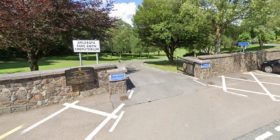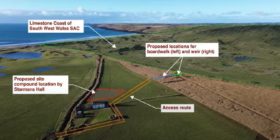Sticky mud and biological goo hold key to predicting coastal erosion

Scientists have taken a huge step towards developing a more reliable way of predicting how climate change will impact estuaries and coastal environments.
Working as part of a collaborative project, led by Bangor University’s School of Ocean Sciences, to assess how fine materials such as mud and sand are moved by water currents around our coastline, and how this movement could change as the result of climate change, Professor Dan Parsons, of Hull University, has pinpointed key ingredients currently missing from the models which help scientists and engineers predict the way coasts and estuaries will be shaped in the future.
He has now had this ground-breaking research published in leading journal Geophysical Research Letters.
Previously, scientists have calculated how coasts and estuaries will change based on simple assumptions that sea and river beds are made up of just sand.
However, in reality, these areas are made up of mixtures of sand, mud and biological life forms, such as worms and diatoms, which move up, down and through the sandbanks, secreting sticky mucus.
Professor Parsons’ research looked at how different levels of sand, mud and biological mucus, impact the stability of different bed forms, such as ripples and dunes, in these environments.
These bed forms are a crucial control on how water moves in terms of flow patterns, speed and which directions it flows in, therefore having an impact on the shape of our estuaries and coasts, including controlling coastal erosion.
Professor Parsons said: “Predicting the effect of climate change on our coasts and estuarine environments is challenging. But no-one has accounted for ‘biological goo’ and ‘sticky mud’ before. Our results show that these factors, and how they change, are really important in terms of getting predictions of coastal and estuarine dynamics right.”
The team, who were funded by the UK Natural Environment Research Council through the COHBED project and which comprised scientists from the Universities of Bangor, St Andrews, Plymouth, and Leeds, along with the National Oceanographic Centre, conducted 16 experiments in the Total Environment Simulator (TES) based at The Deep, in Hull..
Principal Investigator of the COHBED project, Dr Jaco H. Baas, based at Bangor University’s School of Ocean Sciences said: “The TES is a world-class experiment facility, run by the University of Hull, which is designed for modelling environmental fluid and sediment dynamics across a range of settings and conditions. The research done in the TES by Prof. Parsons, together with further laboratory and field data collection by the COHBED team, leads the way in which scientists and practitioners combine biology and physics to predict the stability and movement of ‘sticky’ sediment along our coasts”.
Professor Parsons and the team mixed different quantities of sand, clay and ‘biological goo’ and carefully varied the amount of each across the set of experiments.
They discovered that the physical formations were significantly different with varying amounts of the different factors added.
Ripples and dunes in the beds were significantly more pronounced when just sand was factored in.
Adding clay reduced the size of these bed forms. And when the ‘biological goo’ was added, the bed remained virtually flat throughout the experiments.
Professor Parsons said: “What we are trying to do is to show how important these ‘sticky’ factors are in controlling the size of bed forms in estuarine channels and around our coasts.
“This will allow us to better predict the way climate change and sea-level rise will impact on our coasts and estuaries so we will be able to better model how sandbanks and our coasts are going to change.”
Dr Baas added: “This research may also provide a better clue as to how and when life evolved on Earth, by looking for the signature of these life-forms and clays recorded in ancient geological sediment formations”.
Spotted something? Got a story? Email News@News.Wales











